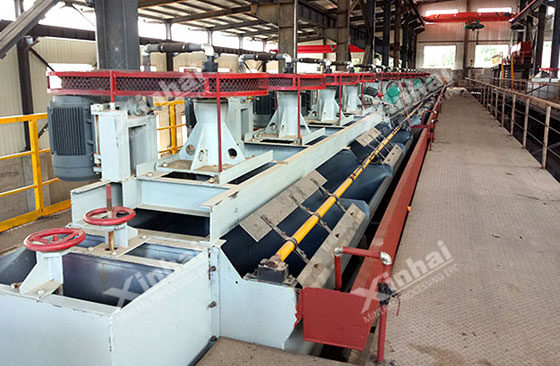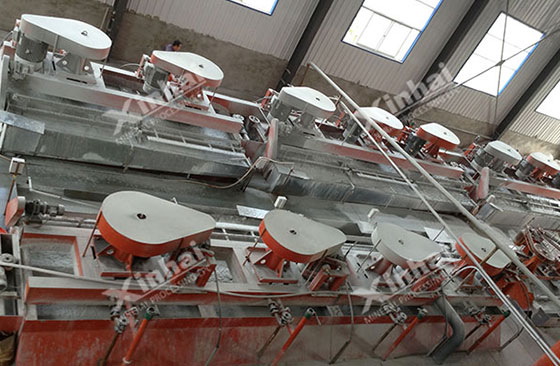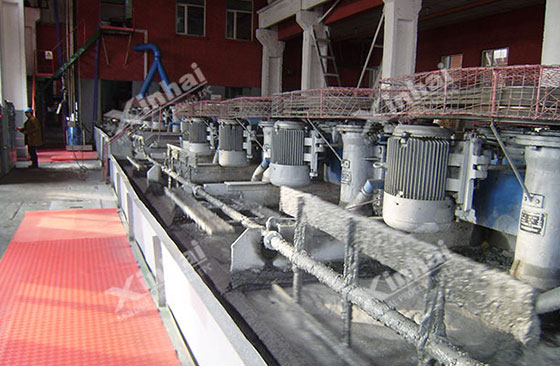
Hematite, a relatively large mineral resource of weakly magnetic iron ore resources, mainly covers hematite, pseudo-iron ore, specularite, and a small amount of siderite and limonite, etc. Among hematite processing methods, flotation separation is one of the common processing methods. Compared to other processing methods, flotation can effectively extract high-quality iron ore from fine-grained materials, thus providing high-quality raw materials for steel production.
Hematite flotation separation:Rely on differences in the properties of the mineral surface. Various reagents are added to the flotation machine, and a large number of diffuse bubbles are generated through stirring and aeration. The suspended mineral grains adhere to the foam, and with the help of the buoyancy of the foam, rise to the liquid surface to form the foam product (concentrate). The minerals not suspended remain in the slurry (tailings).
Common hematite flotation separation methods include hematite flotation separation and hematite combined flotation separation.
Adjust the pH of the pulp in the range of 9 to 11, with fatty acid anions as the collector, sodium carbonate as the regulator to collect hematite minerals in hematite quartzite ores. Collectors commonly used are soybean oil fatty acid sulfated soap, oxidized paraffin soap, crude tall oil, third-line alkali residue, chlorinated acid, oxidized kerosene, sodium sulfonate, cornstarch, etc. Flotation separation methods mainly include positive flotation, reverse flotation, and positive-reverse flotation.
Hematite positive flotation separation uses anionic collectors to collect iron minerals from the raw ore, leaving the gangue minerals in the slurry of the flotation cell. The tailings can be discarded under coarse-grained conditions without desliming. Collectors commonly used are fatty acids or hydrocarbon sulfate and petroleum sulfonate, etc.
This flotation separation has great advantages for processing single hematite, such as simple in reagent use, low in processing cost. However, qualified hematite concentrate can only be obtained after several processes, and the foam is prone to become sticky, making the product difficult to concentrate and filter. Besides, the selection of collectors has relatively large limitations, and the grade of iron concentrate is difficult to increase to more than 65%. Combined with the properties of iron ore, positive flotation separation is less frequently used.

Hematite reverse flotation uses anionic or cationic collectors to remove gangue minerals from the raw ore and leave iron minerals in the flotation cell.
Anionic collector: Use the fatty acid collector for reverse flotation after calcium ion activation. Make sodium hydroxide or sodium hydroxide mixed with sodium carbonate to adjust the pH to above 11, and use starch, sulfonated lignin and dextrin to inhibit iron minerals to achieve reverse flotation. This method is suitable for the flotation of iron ore with high grade and gangue which is relatively easy to float.
Cationic collector: when the pH of the pulp is adjusted to 8~9 with sodium carbonate, starch, dextrin, tannin and other iron ore substances are used to inhibit iron minerals. Then, use amine collectors to remove quartz gangue. The main collector is ether amine, followed by fatty amine.

Hematite positive-reverse flotation separation means that the slurry finishes positive flotation first to scrape out the hematite concentrate foam, then get sent to another flotation machine for reverse flotation, and the hematite concentrate is enriched in the flotation cell finally. Commonly used collector is dodecylamine.
This processing flotation separation can greatly improve the flotation index of hematite ores. But the method is cumbersome and the amount of reagent used is large.

Magnetic- reverse flotation separation is to collect hematite from hematite ore in the way of magnetic separation first, and then use reverse flotation to separate the rest of minerals in neutral pulp (the pulp pH is 7) with dodecylamine cations as the collector. In this way, the quality of iron concentrate can effectively be improved.
The relevant data show that when the dosage of dodecylamine is in the range of 120~180g/t, the mineral processing indicators are good. The grade of iron concentrate can up to 70%, and the recovery rate can reach more than 75%.
Strong magnetic separation-flotation separation is that after coarse grinding of hematite, the coarse-grained monomer quartz and chlorite which is prone to argillation in the ore are removed (qualified tailings) through high-intensity magnetic separation, and then finely grind and get separated by flotation separation.
The above are common hematite flotation methods. For hematite processing, there is not only flotation separation but gravity separation, magnetic separation and combined processing methods, etc. As for which method to choose, there is a recommendation that it’s necessary to carry out the mineral processing test first, then formulate a process that suits you based on the test result. Please remember, do not adopt processes indiscriminately.
To find out more about our products and solutions, please fill out the form below and one of our experts will get back to you shortly.